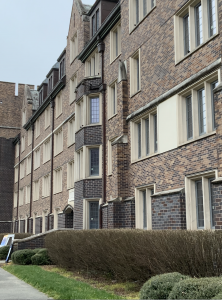
The recording and picture were taken in the Keohane quad at 8 AM. The small, black dots scattered throughout the image are birds, and there were many more birds outside the frame.
I had a virtual internship during the summer, and my internship required me to be on zooms almost every day. Because the days were so nice, I’d often take my zooms in my backyard. Yet, the first time I sat outside on a zoom at the start of the summer, my boss on the other end of the zoom quickly commented how loud the birds were on my end. My boss could hear the birds clearly, but I had spent so much time in my backyard that I forgot the birds were even there. My habitualization fascinated me, and I wondered if I was in a similar situation at Duke. So, I decided to record the Keohane quad in the morning to see if I had been “filtering out” sounds of birds in the quad as a force of habit. When I stepped out into the quad at 8 AM with a conscious effort to take in the sound of chirping birds, the chirping was almost deafening. If the weather was warmer and I was closing my eyes, I would’ve thought I was in a rainforest. I could pick out a variety of chirps from different species as well.
My surprise suggests that we, as Duke students, have an opportunity to reconnect with nature. We tend to focus too much on our daily lives, neglecting the daily sounds and sights of our surroundings. But as COVID forces us into lockdown and into a break from our daily routines, we have the chance to catch the minute details in our environment that we might ignore for our daily, pre-lockdown routine.
The audio doesn’t capture the sounds of people in the distance walking around and a conversation I had with a friend I randomly ran into as I was recording. When I ran into her, I ended the recording because I was focused more on recording the sound of birds than my conversation with my friend. The fact that I ended my recording when I ran into my friend pointed to the notion that ethnographers have a lot of power when it comes to filtering raw information to produce a final ethnography. That is, like what I had done with my friend’s conversation, some details may be consciously omitted by the ethnographer in the final ethnography if the details don’t fit the ethnographer’s narrative and intent.
